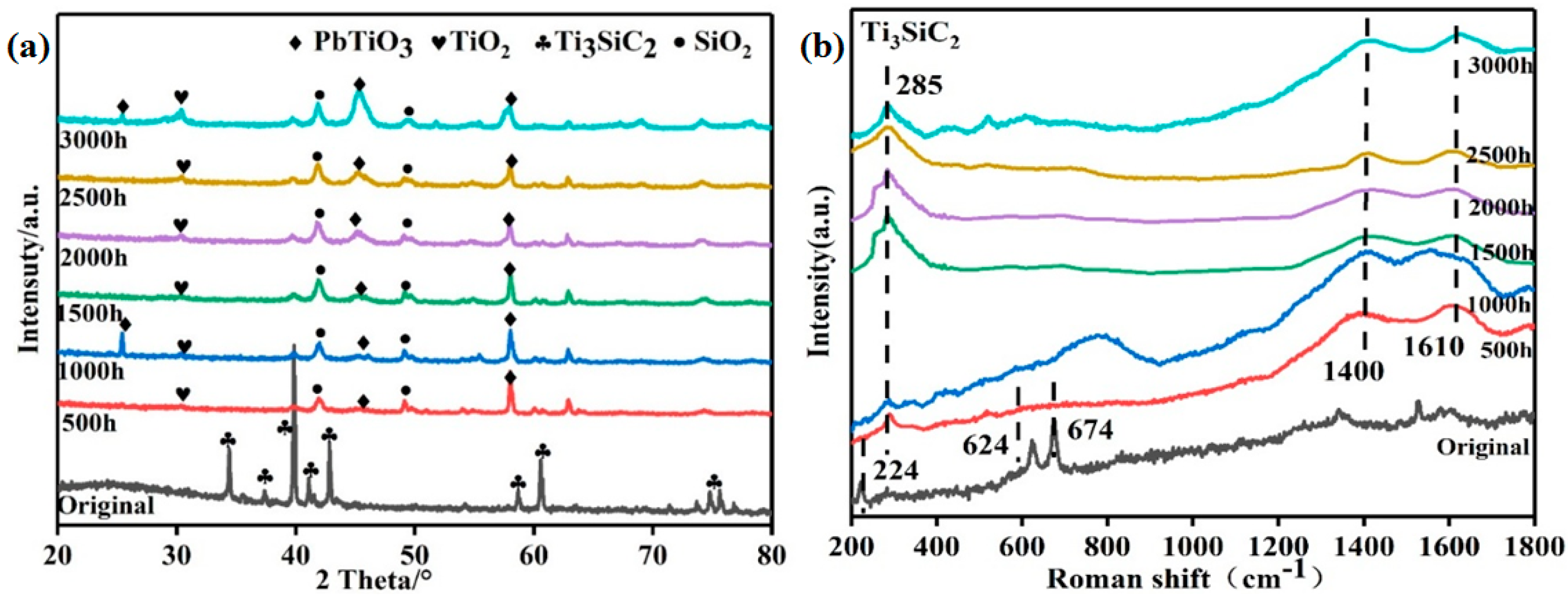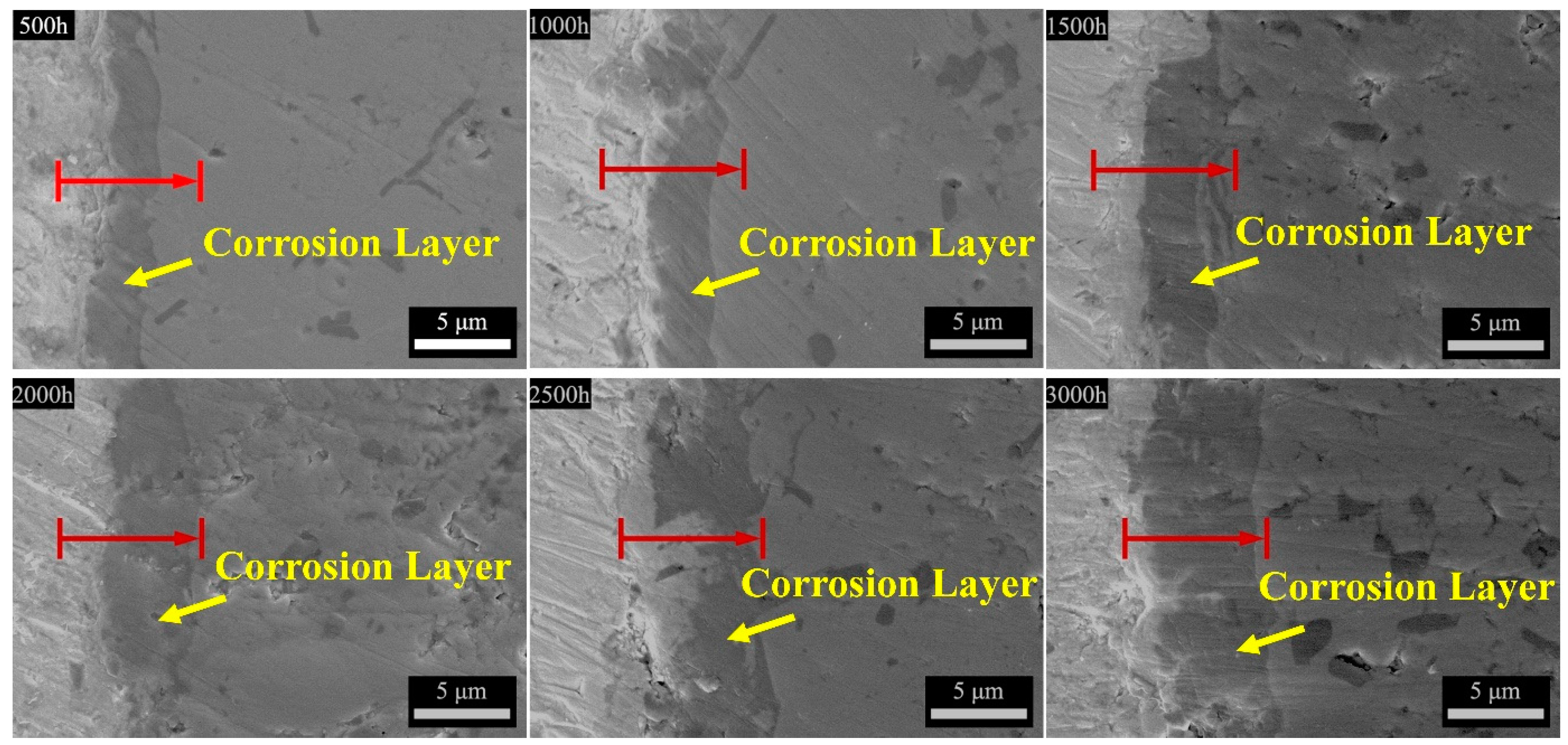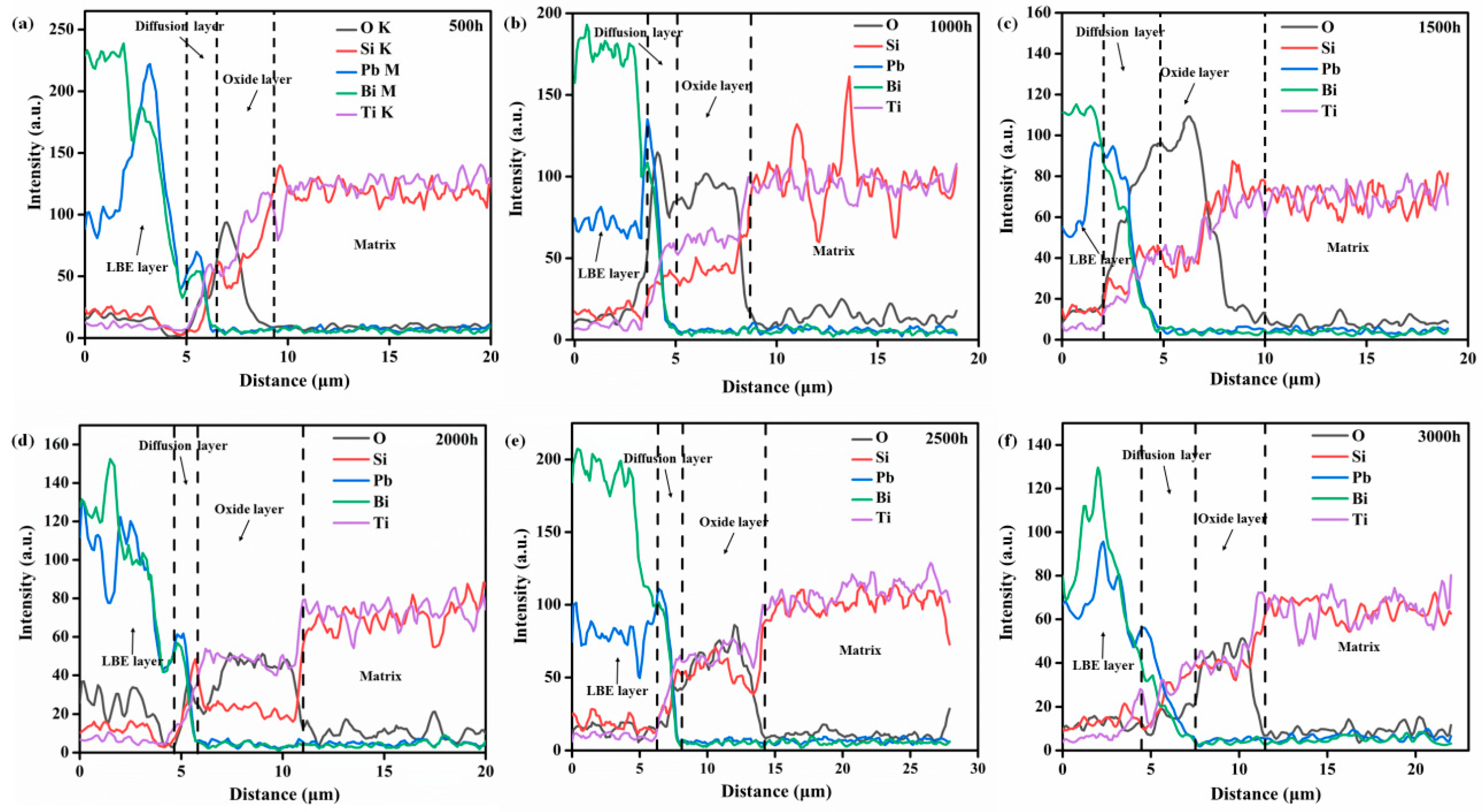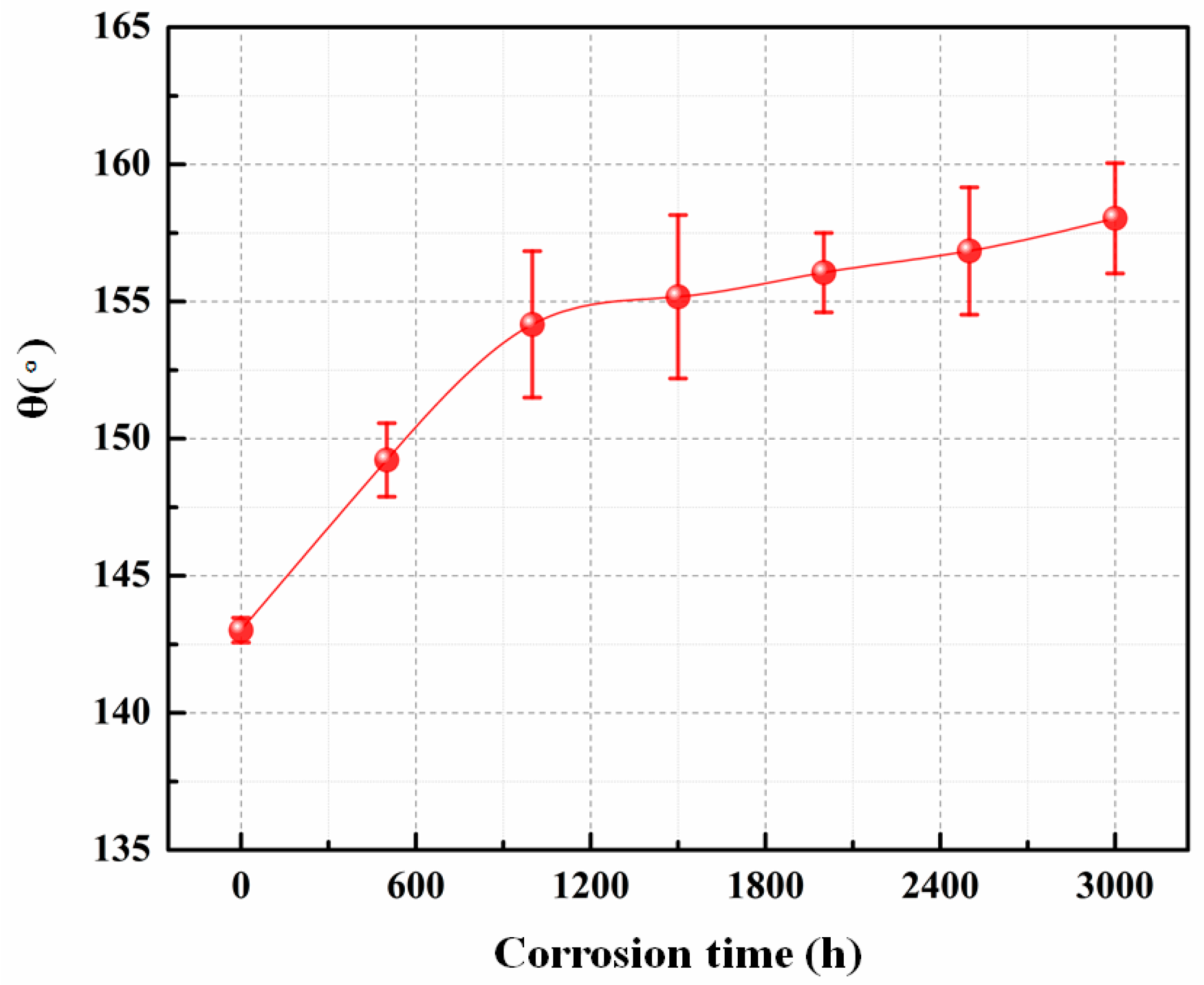Corrosion Behavior of Ti3SiC2 in Flowing Liquid Lead–Bismuth Eutectic at 500 °C
Abstract
:1. Introduction
2. Experimental Procedure
2.1. Materials and Preparation
2.2. Corrosion Tests
2.3. Characterization and Analysis
3. Results and Discussion
3.1. Phase Analysis
3.2. Microstructure of the Cross-Section
3.3. Microhardness Analysis
3.4. Wettability Evaluation
4. Conclusions
Author Contributions
Funding
Institutional Review Board Statement
Informed Consent Statement
Conflicts of Interest
References
- Zhang, J.; Ning, L. Review of the studies on fundamental issues in LBE corrosion. J. Nucl. Mater. 2008, 373, 351–377. [Google Scholar] [CrossRef]
- Hoffman, E.N.; Vinson, D.W.; Sindelar, R.L.; Tallman, D.J.; Kohse, G.; Barsoum, M.W. MAX phase carbides and nitrides: Properties for future nuclear power plant in-core applications and neutron transmutation analysis. Nucl. Eng. Des. 2012, 244, 17–24. [Google Scholar] [CrossRef] [Green Version]
- Barsoum, M.W. The MN+1AXN phases: A new class of solids: Thermodynamically stable nanolaminates. Prog. Solid State Chem. 2000, 28, 201–281. [Google Scholar] [CrossRef]
- Barsoum, M.W. MAX Phases: Properties of Machinable Ternary Carbides and Nitrides; Wiley-VCH Verlag GmbH & Co. KGaA: Weinheim, Germany, 2013. [Google Scholar]
- Gong, X.; Short, M.P.; Auger, T.; Charalampopoulou, E.; Lambrinou, K. Environmental degradation of structural materials in liquid lead- and lead-bismuth eutectic-cooled reactors. Prog. Mater. Sci. 2022, 126, 100920. [Google Scholar] [CrossRef]
- Tallman, D.J.; Hoffman, E.N.; Caspi, E.N.; Garcia-Diaz, B.L.; Kohse, G.; Sindelar, R.L.; Barsoum, M.W. Effect of neutron irradiation on select MAX phases. Acta Mater. 2015, 85, 132–143. [Google Scholar] [CrossRef] [Green Version]
- Tallman, D.J.; He, L.; Garcia-Diaz, B.L.; Hoffman, E.N.; Kohse, G.; Sindelar, R.L.; Barsoum, M.W. Effect of neutron irradiation on defect evolution in Ti3SiC2 and Ti2AlC. J. Nucl. Mater. 2016, 468, 194–206. [Google Scholar] [CrossRef] [Green Version]
- Tallman, D.J.; He, L.; Gan, J.; Caspi, E.N.; Hoffman, E.N.; Barsoum, M.W. Effects of neutron irradiation of Ti3SiC2 and Ti3AlC2 in the 121–1085 °C temperature range. J. Nucl. Mater. 2017, 484, 120–134. [Google Scholar] [CrossRef] [Green Version]
- Lapauw, T.; Tunca, B.; Joris, J.; Jianu, A.; Fetzer, R.; Weisenburger, A.; Vleugels, J.; Lambrinou, K. Interaction of Mn+1AXn phases with oxygen-poor, static and fast-flowing liquid leadbismuth eutectic. J. Nucl. Mater. 2019, 520, 258–272. [Google Scholar] [CrossRef]
- Tunca, B.; Lapauw, T.; Callaert, C.; Hadermann, J.; Delville, R.; Caspi, E.N.; Dahlqvist, M.; Rosén, J.; Marshal, A.; Pradeep, K.G.; et al. Compatibility of Zr2AlC MAX phase-based ceramics with oxygen-poor, static liquid lead–bismuth eutectic. Corros. Sci. 2020, 171, 108704. [Google Scholar] [CrossRef]
- Heinzel, A.; Müller, G.; Weisenburger, A. Compatibility of Ti3SiC2 with liquid Pb and PbBi containing oxygen. J. Nucl. Mater. 2009, 392, 255–258. [Google Scholar] [CrossRef]
- Rivai, A.K.; Takahashi, M. Compatibility of surface-coated steels, refractory metals and ceramics to high temperature lead–bismuth eutectic. Prog. Nucl. Energy 2008, 50, 560–566. [Google Scholar] [CrossRef]
- Barnes, L.A.; Rago, N.; Leibowitz, L. Corrosion of ternary carbides by molten lead. J. Nucl. Mater. 2008, 373, 424–428. [Google Scholar] [CrossRef]
- Utili, M.; Agostini, M.; Coccoluto, G.; Lorenzini, E. Ti3SiC2 as a candidate material for lead cooled fast reactor. Nucl. Eng. Des. 2011, 241, 1295–1300. [Google Scholar] [CrossRef]
- Heinzel, A.; Weisenburger, A.; Müller, G. Long-term corrosion tests of Ti3SiC2 and Ti2AlC in oxygen containing LBE at temperatures up to 700 °C. J. Nucl. Mater. 2016, 482, 114–123. [Google Scholar] [CrossRef]
- Zhu, H.P.; Liu, X.D.; Chang, B.C.; Li, X.; Qi, M.; Wang, Y.; Niu, F.; Ma, Y.; Lyu, L. Corrosion properties of Ti3SiC2 and Ti3AlC2 in static liquid lead–bismuth eutectic at 500 °C. Mater. Corros. 2021, 73, 196–206. [Google Scholar] [CrossRef]
- Zhang, J.; Li, N.; Chen, Y.; Rusanov, A.E. Corrosion behaviors of US steels in flowing lead–bismuth eutectic (LBE). J. Nucl. Mater. 2005, 336, 1–10. [Google Scholar] [CrossRef]
- Bhatti, H.S.; Hussain, S.T.; Khan, F.A.; Hussain, S. Synthesis and induced multiferroicity of perovskite PbTiO3—A review. Appl. Surf. Sci. 2016, 367, 291–306. [Google Scholar] [CrossRef]
- Ni, Z.; Chen, W.; Fan, X.; Kuo, J.L.; Yu, T.; Wee, A.T.S.; Shen, Z.X. Raman Spectroscopy of Epitaxial Graphene on a SiC Substrate. Phys. Rev. B 2008, 77, 1225. [Google Scholar] [CrossRef] [Green Version]
- Rohbeck, N.; Ping, X. Effects of thermal treatment on the mechanical integrity of silicon carbide in HTR fuel up to 2200 °C. J. Nucl. Mater. 2014, 451, 168–178. [Google Scholar] [CrossRef]
- Xue, W.; Yang, X.; Qiu, J.; Liu, H.; Zhao, B.; Xia, H.; Zhou, X.; Huai, P.; Liu, H.; Wang, J. Effects of Cr3+ on the corrosion of SiC in LiF–NaF–KF molten salt. Corros. Sci. 2017, 114, 96–101. [Google Scholar] [CrossRef]
- Yang, X.; Zhang, D.; Liu, M.; Feng, S.; Xue, W.; Liu, H.; Yu, G.; Zhou, X.; Xia, H.; Huai, P.; et al. Corrosion of SiC induced by Hastelloy N alloy and its corrosion products in LiF–NaF–KF molten salt. Corros. Sci. 2016, 106, 62–67. [Google Scholar] [CrossRef]
- Vm, N.; Birjandi, F.C.; Sargolzaei, J. Super-non-wettable surfaces: A review. Colloids Surf. A Physicochem. Eng. Asp. 2014, 448, 93–106. [Google Scholar]






| Corrosion Time (h) | Diffusion Layer Thickness (μm) | Oxide Layer Thickness (μm) | Corrosion Layer Thickness (μm) |
|---|---|---|---|
| 500 | 1.32 (±0.51) | 2.80 (±0.89) | 4.12 (±1.40) |
| 1000 | 1.50 (±0.68) | 3.38 (±1.01) | 4.88 (±1.69) |
| 1500 | 2.73 (±0.67) | 3.43 (±0.83) | 6.16 (±1.50) |
| 2000 | 2.52 (±0.72) | 4.05 (±0.93) | 6.57 (±1.65) |
| 2500 | 1.81 (±0.73) | 6.32 (±1.08) | 8.13 (±1.81) |
| 3000 | 2.14 (±0.87) | 6.98 (±0.92) | 9.12 (±1.79) |
Publisher’s Note: MDPI stays neutral with regard to jurisdictional claims in published maps and institutional affiliations. |
© 2022 by the authors. Licensee MDPI, Basel, Switzerland. This article is an open access article distributed under the terms and conditions of the Creative Commons Attribution (CC BY) license (https://creativecommons.org/licenses/by/4.0/).
Share and Cite
Lyu, L.; Qiu, X.; Yue, H.; Zhou, M.; Zhu, H. Corrosion Behavior of Ti3SiC2 in Flowing Liquid Lead–Bismuth Eutectic at 500 °C. Materials 2022, 15, 7406. https://doi.org/10.3390/ma15217406
Lyu L, Qiu X, Yue H, Zhou M, Zhu H. Corrosion Behavior of Ti3SiC2 in Flowing Liquid Lead–Bismuth Eutectic at 500 °C. Materials. 2022; 15(21):7406. https://doi.org/10.3390/ma15217406
Chicago/Turabian StyleLyu, Liangliang, Xi Qiu, Huifang Yue, Mingyang Zhou, and Huiping Zhu. 2022. "Corrosion Behavior of Ti3SiC2 in Flowing Liquid Lead–Bismuth Eutectic at 500 °C" Materials 15, no. 21: 7406. https://doi.org/10.3390/ma15217406
APA StyleLyu, L., Qiu, X., Yue, H., Zhou, M., & Zhu, H. (2022). Corrosion Behavior of Ti3SiC2 in Flowing Liquid Lead–Bismuth Eutectic at 500 °C. Materials, 15(21), 7406. https://doi.org/10.3390/ma15217406






